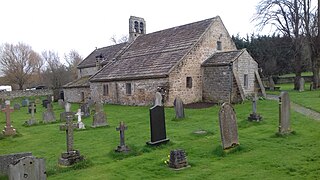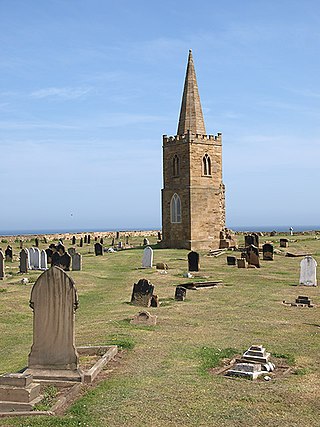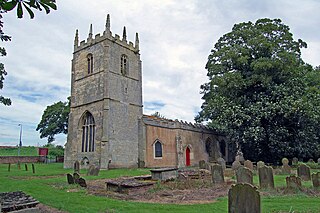
Bawtry is a market town and civil parish in the City of Doncaster in South Yorkshire, England. It lies 8 miles (13 km) south-east of Doncaster, 10 miles (16 km) west of Gainsborough and 8 miles (13 km) north-west of Retford, on the border with Nottinghamshire and close to Lincolnshire. The town was historically divided between the West Riding of Yorkshire and Nottinghamshire. Its population of 3,204 in the 2001 UK census increased to 3,573 in 2011, and was put at 3,519 in 2019. Nearby settlements include Austerfield, Everton, Scrooby, Blyth, Bircotes and Tickhill.

Austerfield is a village and civil parish in the City of Doncaster, South Yorkshire, England. It is 1 mile (1.6 km) to the north-east of the market town of Bawtry on the A614 road, and adjacent to the hamlet of Newington in Nottinghamshire, close to the River Idle. The population in 2001 was 571, which fell to 536 at the 2011 Census.

Ss Leonard & Mary Catholic Church is a medieval church situated in Malton, North Yorkshire, England, now serving a parish in the Roman Catholic Diocese of Middlesbrough. It is a Grade II* listed building in the National Heritage List for England, and retains at least 24 pieces of medieval figurative carving.

Misson is a village and civil parish in Nottinghamshire, England. It is located 12 miles north of Retford, and not directly accessible from the rest of Nottinghamshire, as it is on the north bank of the River Idle. Misson Springs, which lie north of the village itself, is the northernmost place within the county. The parish also includes the hamlet of Newington, at its western edge. According to the 2001 census it had a population of 698, increasing to 711 at the 2011 census, and marginally more to 713 residents at the 2021 census.

St Helen's Church is an Anglican church in the village of Churchtown in Lancashire, England. Historically, it was the parish church of Garstang; today, as Garstang is split into more than one ecclesiastical parish, St Helen's parish is Garstang St Helen (Churchtown). It is in the Diocese of Blackburn. It has been designated a Grade I listed building by English Heritage. St Helen's is known as the "cathedral of The Fylde".

The Church of St John the Evangelist is a Grade I listed Church of England parish church dedicated to John the Evangelist, in Corby Glen, Lincolnshire, England. The church is 9 miles (14 km) south-east of Grantham, and in the South Kesteven Lincolnshire Vales. It is noted in particular for its 14th- and 15th-century medieval wall paintings.

The Parish Church of St Andrew, Finghall, is the parish church for the village of Finghall in North Yorkshire, England. The building is located on the site of a much earlier Anglo-Saxon church and has some remnants of that era incorporated into the building, though the present structure dates back to the 12th century. The church is nearer to the hamlet of Akebar than it is to Finghall, which is 0.5 miles (0.80 km) to the south, because the church was originally in a medieval village that was deserted when it was ravaged by plague. The building is now a grade II* listed structure and is still used for worship.

The Church of St Gregory, Bedale is the parish church for the town of Bedale in North Yorkshire, England. It is the main church of the benefice of Bedale and Leeming and Thornton Watlass. A stone church in Bedale was mentioned in the Domesday Book, but the present structure dates back to the latter part of the 12th century, with further restorations over the last 800 years. The grade I listed building has many notable features including a medieval image of a left handed St George fighting a dragon and the tower, set to the western side, which was built with a portcullis in a defensive capacity.

The Church of St Oswald, Lythe, is the parish church for the village of Lythe, 4 miles (6.4 km) west, north west of Whitby in North Yorkshire, England. The church is at the top of Lythe Bank and is just east of the village on the A174 road.

St Mary's Church Hornby, is the parish church for the village of Hornby, Richmondshire in North Yorkshire, England. The church is one of six in the Benefice of Lower Wensleydale. The oldest parts of the building date back to the 11th century. It is 6 miles (9.7 km) south east of Richmond and 5 miles (8 km) north of Bedale.

The Church of St Patrick, is the parish church for the village and parish of Patrick Brompton in North Yorkshire, England. The church is one of six in the Benefice of Lower Wensleydale and the oldest parts of the building date back to the 11th century. It is 6 miles (9.7 km) south east of Richmond and 4 miles (6 km) north of Bedale situated on the A684 road.

The Church of St Andrew, Grinton, is the parish church for the village of Grinton in North Yorkshire, England. The grade I listed structure has also been called The Cathedral of the Dales, and as the only parish church in Upper Swaledale, it was at the end of the Swaledale Corpse Way, where those who had died in the upper valley, were brought for burial. Grinton never developed past village status, but its noted crossing point of the River Swale afforded it more importance than other settlements.

The Church of St Oswald, Filey, is a parish church in the North Yorkshire town of Filey, England. The church dates from the 12th and 13th centuries, with some embattlements added in the 15th century. The building is now grade I listed and was described by Pevsner as "easily the finest church in the north-east corner of the East Riding".

The Church of St Mary the Virgin, Richmond, is the Anglican parish church in the town of Richmond in North Yorkshire, England. Previously, there was another church, the Church of the Holy Trinity, which served as a chapel, and in the early part of the twentieth century, it was officiated over by the incumbent of St Mary's. In the 1960s, Holy Trinity was deconsecrated and now serves as the Green Howards' museum in the town.

Scaftworth is a hamlet and civil parish within the Bassetlaw district of north Nottinghamshire, England.

St Germain's Churchyard is a large cemetery overlooking the North Sea at Marske-by-the-Sea, North Yorkshire, England. Its church tower is a grade II listed structure at the midpoint to the yard and a landmark for sailors out on the sea. It is a remnant of a demolished church, services at St Germain's were replaced in 1876 by St Mark's.

The Church of St Lambert, Burneston, is the Anglican parish church for the village of Burneston in North Yorkshire, England. The church was built progressively in the 14th, 15th and 16th centuries, with some later additions and is now a grade I listed structure. It is the only Anglican church in England to be dedicated to St Lambert, and one of its former vicars, Canon John Hartley, was noted for being a winner at the Men's Singles championship at Wimbledon two years running.

The Church of the Ascension is an Anglican church in the village of Whixley, North Yorkshire, England. Whilst the Domesday Book entry for Whixley mentions the presence of a church, the main fabric of the existing church dates to the 14th century. Up until it was renovated in the 19th century, it was dedicated to St James, but was rededicated as the Church of the Ascension, and it is now a grade II* listed building. Nikolaus Pevsner notes that it is unusual for a village church to be composed of mostly the same style of architecture (Decorated).
Bawtry Wharf was a small Medieval port in the town of Bawtry, West Riding of Yorkshire, England. The port operated from a wharf on the River Idle, a small body of water that flowed eastwards inland from Bawtry to the River Trent, and was navigable to sailing ships. Bawtry Wharf flourished as a port from the 12th century until the middle of the 19th century. Whilst the port was in a decline by the early 19th century, the building of a railway viaduct near the town necessitated diverting the River Idle which isolated the port from the main river stem, and the site silted up after losing its water.

The Church of St Mary Magdalene is an Anglican church in the hamlet of Whitgift, East Riding of Yorkshire, England. The church is noted for its clock which displays the number 13 in Roman numerals in what should be the 12 o'clock position – the only one in Britain to do so. The church itself is a grade I listed building, and the churchyard contains two grade II listed structures.




















